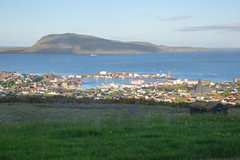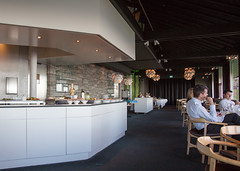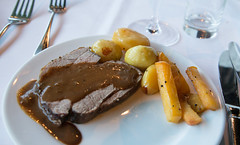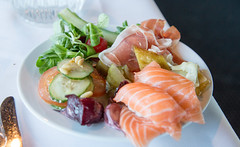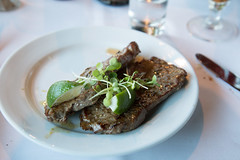Continuing the Offbeat Eats tradition of going places that are, well, offbeat, our goal this year was to finally visit the Faroe Islands. Originally coming up on our radar during the trip to Iceland, a few simple google image searches quickly found that, while most Americans had never actually heard of the Faroes, they are a wonderland of hiking and puffin-watching. So after a few years of planning, this year we finally did our trip, so after a short layover in Iceland, we boarded a plane at the Reykjavik Domestic Airport (walking distance from downtown), and, without any customs or immigration, and a very pleasant flight on Atlantic Airways involving two shockingly short runways, we soon found ourselves arriving at Vagar Airport at 8pm local time.
The timing of our flight from Reykjavik to Vagar was pretty lousy: by the time we got our luggage, got our rental car, and drove the tunnels and fjords to get to Torshavn, it was 9:55 pm, and pretty much all the dining options in Tórshavn on a Monday night were closed. Except for the restaurant in the adjacent 4 star hotel, Gras, which was nice enough to let two slightly disheveled travelers eat at the dinner buffet that had technically closed at 9:30.
While a little bit on the spendy side (hey, it is a four star hotel!), we actually had a great meal. First all of, if there is one thing that the Faroes are known for, it’s lots of sheep, and they do have a tendency to make it onto the menu, either in the form of Skerpikjøt (wind-dried mutton, more on that in a later post), or for the more international crowd at a place like Gras, in the form of a nice lamb roast. And it was a particularly flavorful lamb served up with a rich gravy, which we rather enjoyed.
If there’s anything else that the Faroese are known for in culinary circles, it’s salmon, since the largest industry in the islands is aquaculture, primarily raising salmon for food and for export. And, indeed, the dinner buffer features no fewer than five salmon dishes, with my favorite being salmon sushi. The salmon definitely had the taste and texture of farm-raised salmon, but was still quite flavorful, and I definitely found myself looking forward to other salmon dishes I’d experience in the Faroes.
Next up was another item that overlapped with Icelandic cuisine: the Faroes also make heavy use of langoustines, and those served up by Gras were particularly nice: freshly sautéed with a bit of garlic butter and served up with a nice micro-green salad, this was also a great use of locally-harvested ingredients.
Finally, while Faroese cuisine doesn’t generally use a lot of beef, Gras also had some pleasantly done minute steaks, which served as a nice way to round out the meal, along with a nice bottle of Okkara Rinku-Steinur beer, from one of the two breweries in the Faroes.
While definitely geared towards the international traveler and not “local” fare, and a bit pricey to boot, Gras was a very splendid meal, served in a very pleasant dining room overlooking Tórshavn, and with a staff that was quite friendly and cordial despite the lateness of our arrival. I’d love to come back and try them for another meal on a future visit.

